

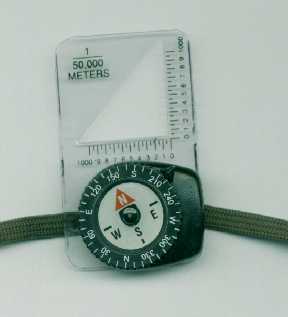
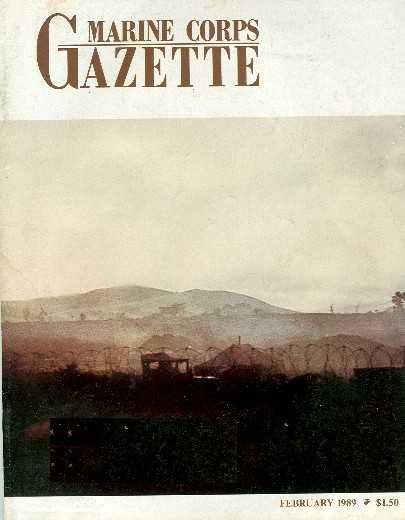
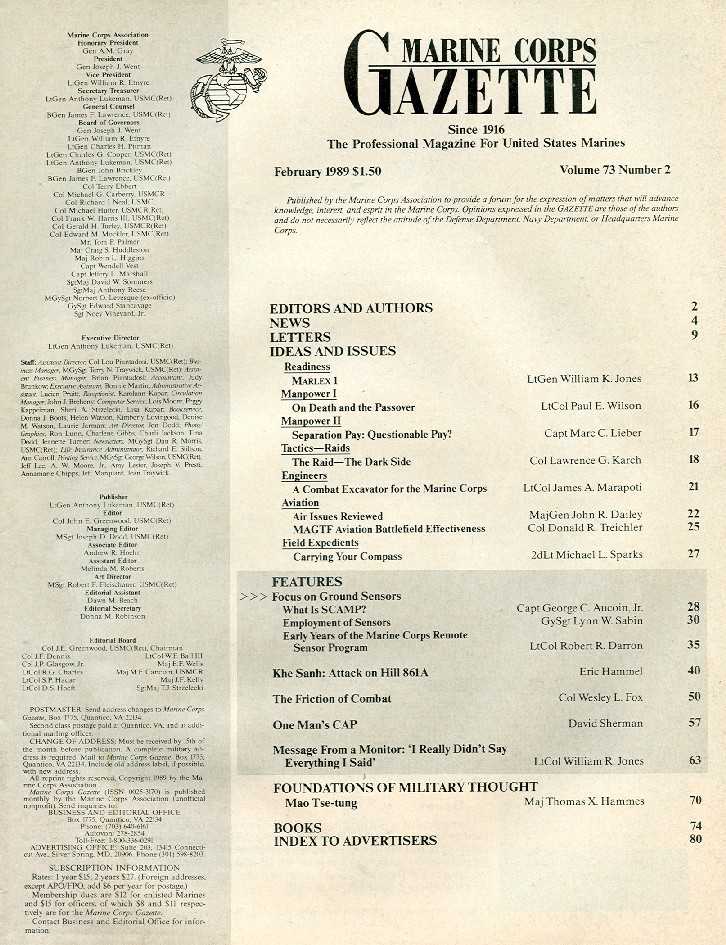
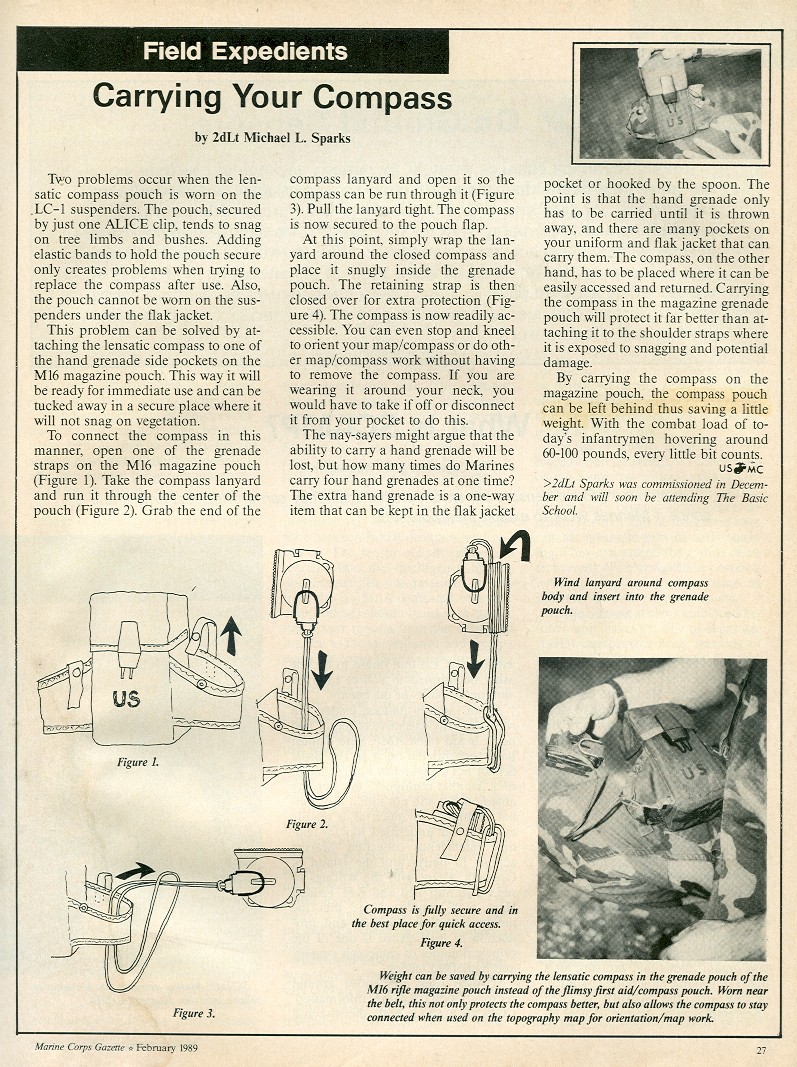
You can buy a G.I. tritium-powered lensatic compass from Cammenga...good for 10 years--no batteries required!
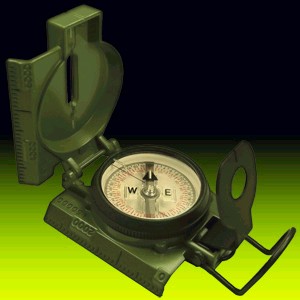
http://store.cammenga.com/scripts/prodView.asp?idproduct=47
This lensatic compass has been used by U.S. troops, foreign militaries, law enforcement, special forces, and outdoor enthusiasts of every variety for decades. CAMMENGA has been the government's exclusive manufacturer since September, 1992. Tritium light sources provide readability in total darkness. Features of this most rugged and accurate compass are:
Luminosity: Tritium
Jewel bearing: Sapphire
Rotating Bezel: Bi-directional
Climate capacity: -50 to+150 degrees F.
Frame Materials: Cast Aluminum
Lanyard: Included
Waterproof: Yes
Carrying Pouch: LC-1 pouch with belt clip
Condition: New
Expected luminous life: 10 years
Accuracy: Per MIL-PRF-10436N
Dial readings: Degrees and mils.
Casting: Aluminum
Damping process: Induction (no liquid required)
Color, body: Olive Drab
Color, pouch: Olive Drab
Warranty: Included, 1 year
Cammenga Lensatic Compass Instruction Book (PDF)
www.cammenga.com/pdf_assets/CAM_INS_BK.pdf
U.S. Army Field Manual FM 21-26 Land Navigation
www.cammenga.com/pdf_assets/CAMM_US_ARMY_FIELDMANUAL.pdf
MAKING THE MOST OF COMMERCIAL OFF-THE-SHELF
The main mission of the wrist compass is to give cardinal directions so the Pararooper/Soldier can starting from his entry into battle from the delivery vehicle have cardinal direction, situational awareness. For a Paratrooper it means being able to glance down at the wrist and get a heading to steer his parachute towards his landing point on the ground below. Immediately after canopy opening, the Paratrooper should be facing the rear away from the direction of flight, which should be with-the-wind, but often he can be spun around. With less than 60 seconds under canopy at 15 feet per second descent rate, the upwind advantage he has cannot be wasted trying to figure out where he is facing. When we jump under radar coverage using low level parachute assault tactics under 500 feet, the time is even less.
 youtube.com/watch?v=_VUsHQuWgug
youtube.com/watch?v=_VUsHQuWgug
Upon landing, the Paratrooper has to quickly transition to fighting order and rush to the assembly area. The wrist compass is vital in steering him to his designated assembly area which is often shielded by night and should be shielded by friendly smokescreen. Keep the wrist compass covered by your gloves when in the field to prevent shine.
For this glance down capability, the wrist compass dial must glow-in-the-dark and have large clear markings.
WHICH WRIST COMPASS?
The only wrist compass on the market today POWERED BY TRITIUM is the Cammenga Tritium Wrist Compass
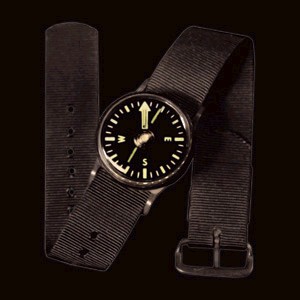
http://store.cammenga.com/scripts/prodView.asp?idproduct=53
Lightweight and accurate. The CAMMENGA TRITIUM WRIST COMPASS provides easy on the go referencing for land navigation at day or night. Constructed with a machined aluminum casing for durability in the most demanding conditions. Easy to read 10-degree phosphorescent graduations are enhanced with Tritium Micro Lights for visibility in total darkness, maintenance-free, for over ten years. Includes a heavy-duty nylon wristband.
Tony Wilk's Guide to Using the Cammenga Wrist Compass (PDF file)
The main drawbacks is the Cammenga Tritium Wrist Compass DOES NOT HAVE NUMERICAL MARKINGS FORCING YOU TO HAVE TO REMEMBER BY COUNTING TICK MARKS and it has NO BEZEL RING to align where the north arrow is facing to verify the direction you are going! The Cammenga also needs a cover flap to prevent shine when not in use and a way to connect it to the BDU/ACU sleeve--without wrapping around the wrist.
The Cammenga Wrist compass is POTENTIALLY the best because its TRITIUM-powered and not filled with liquid and prone to developing a bubble. However, without a bezel ring and degrees shown in numbers, it's nearly worthless! Try suggesting to Cammenga to add a bezel and actual numbers and be prepared for a run-around of myriad excuses.
The two next best wrist compasses have the propensity to either develop bubbles or do not shine reliably BECAUSE THEY ARE NOT TRITIUM POWERED--but are great for day use are the Suunto M-9 (2151 Las Palma Dr. Carlsbad, Ca. 92009) and the Silva Wrist-Band compass depicted above. The Suunto is the overall best wrist compass available today with its large luminous circular dial but it has its degree numbers written backwards in order to allow the Paratrooper to "sight" through its near end for dead reckoning land navigation. You cannot look straight down at the Suunto face and read the dial at the top, you have to force yourself to remember to read the dial from the BOTTOM 6 o'clock position. The Silva numbers are straight-forward, but not as large as one would wish for. BOTH compasses have bezel rings that can rotate so the Paratrooper can set an azimuth and follow it with the north magnetic needle acting as a steadying reference.
Try contacting Suunto and suggest that they make the world's BEST wrist compass by providing some tritium under the window for reading degree numbers at night and on the bezel ring and north arrow for verifying your bearing during night movements...they will also give you the run-around wanting a huge USG cash influx to perfect their product....
Since we don't have a wrist compass that can be read at night without shining a flashlight or having a major headache, the watch with digital compass can be helpful at night since they have back-lights. However, the BEST combination would be a GPS wrist or forearm receiver that has a TIME display so you only have to have one thing strapped to your arms--not the current two (time piece and GPS/compass). The ideal "Garming Foretrex 501" would also have a solar cell to plus up by trickle charge its batteriess whenever light is available.
The second function of a wrist is to be a navigate-on-the-move means and general back up to the main more accurate, G.I. lensatic compass that closed cannot provide direction so you have to stop to use it.
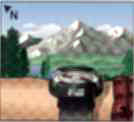
SIGHTING FEATURE OF M9 SUUNTO COMPASS
The Suunto M-9 is awesome in that it has a sighting feature like the lensatic compass but without having to use a mirror or a moving lens and a sighting wire piece to do this. The price for this is that the degree numbers are written backwards, which can be confusing to the unwary. The Silva wrist compass has no sighting feature.
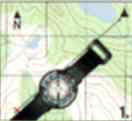
2. The illustrations depicted here from Suunto omits this next VITAL step. Rotate your map UNDERNEATH your compass a few degrees to the west or east to replicate the G-M angle differance shown at the bottom of your map. DO NOT MOVE YOUR COMPASS! NIMA/DMA maps indicate the G-M angle at the bottom in the legend with a little drawing showing the east or west G-M angle. See the illustration below for a sample G-M angle drawing.
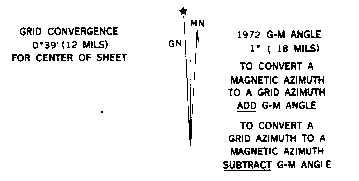

The second part of backing up the main G.I. lensatic compass (NSN 6605-01-196-6971) is to act as a map (grid) azimuth reader if the protractor is lost. First, you must orient the map to magnetic north with the compass body and north needle aligned with one of the map's north-south grid lines. Then, you must shift the map underneath the compass to replicate the actual differance between magnetic north which is in Canada and grid north which converges at the North Pole. Holding this steady, you can then take your plotted points you are traveling to on the map and measure their azimuth directions using a compass. A protractor doesn't need to be aligned to magnetic-grid since its just aligned to the map north-south grid lines, but protractors are easily lost. The Suunto has a straight endge formed by the wrist strap holders that can be used to measure grid azimuths using the alignment technique described above, and then looking at the sighting window for the azimuth; the Silva doesn't with its rounded body edges.
Neither compasses have a grid reader, but one can be cut out from the U.S. Army protractor and attached to the Silva compass using a short piece of gutted "550" para cord (see above). Attach this compass to the zipper of your ECWCS Gore-Tex (c) parka or girth-hitch to the button hole of one of your BDU/ACU pockets.
THE IDEAL "M-21" WRIST COMPASS
The optimal wrist would have all of the best features described above to be the ultimate second compass backing up the lensatic compass. The following description is an open offer to Silva and Suunto to make this compass a reality.
Clear body.
Like other Silva, Suunto compasses, the new M-21 should be clear so it can be laid on top of topographical maps to act as a straight-forward protractor. The wrist strips should be looped and sewn to seperate ends to not run under the clear compass body. This way, the compass can be quickly removed and laid on top of the topo map.
Compass dial with false edge
To avoid the potential confusion that the Suunto M-9 creates with the degrees written backwards, the compass dial would have a false edge or rim on the end that can only be viewed through the side sighting window. Looking down for protractor/quick reference functions the degrees and MILS would be self-explanatory.
MILS and degrees
The compass faces would be in BOTH degrees and mils for accurate artillery calls for fire communications, which use mils.
Tritium luminescence
Glow-in-the-dark paint/colorings simply fade and stop working a short time after being charged by a flashlight or the sun. The only reliable luminescence is from tritium radioactive vials like the G.I. compass has. The M-21 should have a vial in the north arrow part of the floating compass dial, a vial on the front base indicating the direction of movement and TWO vials on the bezel ring. These two light slashes are what you keep the north arrow in between when following a set azimuth forward as indicated by the front base vial.
The wrist straps would have Velcro┬(c) so the bottom strap can have a cover flap strecth over the compass face to protect it from the elemrents and for camouflage. Velcro (c) would also allow it to stay in an open position during use.
Grid Readers
The M-21 wrist band holders themselves would have etched on their sides 1:50,000 and 1:100,000 increments for accurate measuring of points within a grid square.
Its hoped that SOME compass maker reading this proposal will step forward and make us a M-21 wrist compass/protractor for the continued battle success of the U.S. Army into the 21st century.
FEEDBACK!!!

"Dear Sir,
I am an Army Cadet at the University of XXXXXXX. I was with X/XXX PIR the summer of 99' during Cadet Troop Leader Training. We jumped into Netherlands DZ. I was wearing my Suunto M-9. I love that compass as it has helped me many times in the field. The only problem was that as I did my PLF one of the plastic bars that hold the compass to the band broke.
I think that I had the band too tight and as I hit it put too much strain on the bar. I would suggest that a Paratrooper either wear it loosely (which may cause a hazard) or place it into his BDU chest pocket for quick recovery once out of the chute and has his weapon in operation.
If it does break it is still useful. I put mine through the left chest pocket button hole for quick reference while on patrol. It worked just like if it were on my wrist.
Thank you and please respond with your Ideas
RLTW and AIRBORNE.
XXXXXXXXXX
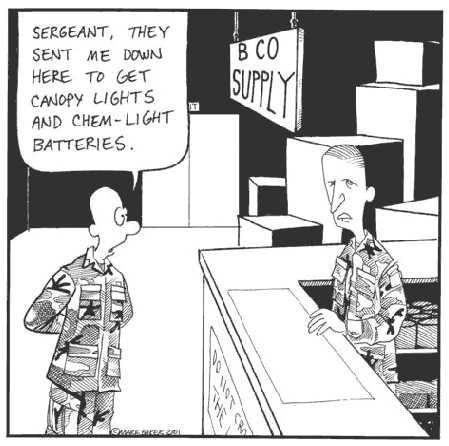
RETURN TO U.S. ARMY AIRBORNE EQUIPMENT SHOP
